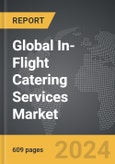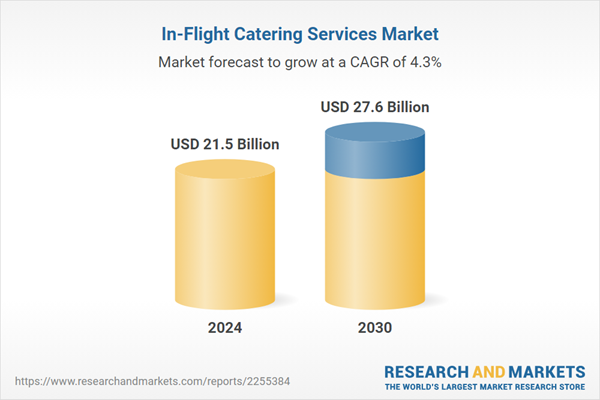The global market for In-Flight Catering Services was valued at US$21.5 Billion in 2024 and is projected to reach US$27.6 Billion by 2030, growing at a CAGR of 4.3% from 2024 to 2030. This comprehensive report provides an in-depth analysis of market trends, drivers, and forecasts, helping you make informed business decisions. The report includes the most recent global tariff developments and how they impact the In-Flight Catering Services market.
The industry has evolved significantly with changing passenger expectations and advancements in food technology. Airlines now partner with renowned chefs and culinary brands to offer gourmet dining experiences, especially in premium classes. There is also an increasing focus on sustainability, with many airlines striving to reduce food waste and incorporate local and organic ingredients. Specialized dietary menus, such as gluten-free, vegan, and halal options, have become standard, reflecting broader societal trends towards health-conscious and ethical eating. Technology plays a crucial role in modernizing in-flight services, with software for managing inventory, tracking meal preferences, and ensuring precise logistics from kitchen to cabin. Innovations like blast chilling and vacuum sealing have also improved the efficiency and safety of meal storage and transportation, allowing airlines to maintain a high standard of meal quality and variety.
The growth in the in-flight catering services market is driven by several factors, including the expansion of international air travel, heightened passenger expectations for quality and service, and competitive pressures among airlines to enhance customer loyalty. As global tourism and business travel continue to grow, airlines are investing in superior catering services to differentiate themselves in a crowded market. The increasing demand for personalized travel experiences has also led airlines to offer more customized meal options and higher-quality food, leveraging in-flight catering as a crucial element of the passenger experience. Moreover, the trend towards more health-conscious and environmentally sustainable practices influences airlines to adopt green catering solutions and healthier meal options, responding to consumer demand for more responsible and lifestyle-aligned services. Technological advancements in food preservation, safety, and logistics support these efforts, making it possible for airlines to elevate the in-flight dining experience while managing costs and ensuring compliance with international health and safety standards.
Segments: Aircraft Class (Economy Class, Business Class, and First Class); Flight Type (Full Service, and Low Cost); and Food Type (Meals, Bakery & Confectionery, Beverages, and Other Food Types).
Geographic Regions/Countries: World; USA; Canada; Japan; China; Europe; France; Germany; Italy; UK; Spain; Russia; Rest of Europe; Asia-Pacific; Australia; India; South Korea; Rest of Asia-Pacific; Latin America; Argentina; Brazil; Mexico; Rest of Latin America; Middle East; Iran; Israel; Saudi Arabia; UAE; Rest of Middle East; Africa.
The analysts continuously track trade developments worldwide, drawing insights from leading global economists and over 200 industry and policy institutions, including think tanks, trade organizations, and national economic advisory bodies. This intelligence is integrated into forecasting models to provide timely, data-driven analysis of emerging risks and opportunities.
Global In-Flight Catering Services Market - Key Trends & Drivers Summarized
In-flight catering services are a critical component of the aviation industry, providing meals and beverages to passengers aboard commercial flights. This sector not only enhances the travel experience but also reflects the airline's brand and commitment to passenger satisfaction. The logistics of in-flight catering involve complex coordination, as meals must be prepared in ground-based kitchens, transported securely to aircraft, and served efficiently at high altitudes. Menus are meticulously planned to cater to diverse passenger preferences and dietary requirements, often reflecting the cultural and culinary routes that airlines operate. Safety and hygiene are paramount, with strict regulations governing food handling, preparation, and storage to prevent contamination and ensure food quality despite the constraints of preparing food intended to be consumed hours later in a different environment.The industry has evolved significantly with changing passenger expectations and advancements in food technology. Airlines now partner with renowned chefs and culinary brands to offer gourmet dining experiences, especially in premium classes. There is also an increasing focus on sustainability, with many airlines striving to reduce food waste and incorporate local and organic ingredients. Specialized dietary menus, such as gluten-free, vegan, and halal options, have become standard, reflecting broader societal trends towards health-conscious and ethical eating. Technology plays a crucial role in modernizing in-flight services, with software for managing inventory, tracking meal preferences, and ensuring precise logistics from kitchen to cabin. Innovations like blast chilling and vacuum sealing have also improved the efficiency and safety of meal storage and transportation, allowing airlines to maintain a high standard of meal quality and variety.
The growth in the in-flight catering services market is driven by several factors, including the expansion of international air travel, heightened passenger expectations for quality and service, and competitive pressures among airlines to enhance customer loyalty. As global tourism and business travel continue to grow, airlines are investing in superior catering services to differentiate themselves in a crowded market. The increasing demand for personalized travel experiences has also led airlines to offer more customized meal options and higher-quality food, leveraging in-flight catering as a crucial element of the passenger experience. Moreover, the trend towards more health-conscious and environmentally sustainable practices influences airlines to adopt green catering solutions and healthier meal options, responding to consumer demand for more responsible and lifestyle-aligned services. Technological advancements in food preservation, safety, and logistics support these efforts, making it possible for airlines to elevate the in-flight dining experience while managing costs and ensuring compliance with international health and safety standards.
Report Scope
The report analyzes the In-Flight Catering Services market, presented in terms of units. The analysis covers the key segments and geographic regions outlined below.Segments: Aircraft Class (Economy Class, Business Class, and First Class); Flight Type (Full Service, and Low Cost); and Food Type (Meals, Bakery & Confectionery, Beverages, and Other Food Types).
Geographic Regions/Countries: World; USA; Canada; Japan; China; Europe; France; Germany; Italy; UK; Spain; Russia; Rest of Europe; Asia-Pacific; Australia; India; South Korea; Rest of Asia-Pacific; Latin America; Argentina; Brazil; Mexico; Rest of Latin America; Middle East; Iran; Israel; Saudi Arabia; UAE; Rest of Middle East; Africa.
Key Insights:
- Market Growth: Understand the significant growth trajectory of the Economy Class segment, which is expected to reach US$14.2 Billion by 2030 with a CAGR of a 4.8%. The Business Class segment is also set to grow at 3.9% CAGR over the analysis period.
- Regional Analysis: Gain insights into the U.S. market, valued at $4.5 Billion in 2024, and China, forecasted to grow at an impressive 5.9% CAGR to reach $3.7 Billion by 2030. Discover growth trends in other key regions, including Japan, Canada, Germany, and the Asia-Pacific.
Why You Should Buy This Report:
- Detailed Market Analysis: Access a thorough analysis of the Global In-Flight Catering Services Market, covering all major geographic regions and market segments.
- Competitive Insights: Get an overview of the competitive landscape, including the market presence of major players across different geographies.
- Future Trends and Drivers: Understand the key trends and drivers shaping the future of the Global In-Flight Catering Services Market.
- Actionable Insights: Benefit from actionable insights that can help you identify new revenue opportunities and make strategic business decisions.
Key Questions Answered:
- How is the Global In-Flight Catering Services Market expected to evolve by 2030?
- What are the main drivers and restraints affecting the market?
- Which market segments will grow the most over the forecast period?
- How will market shares for different regions and segments change by 2030?
- Who are the leading players in the market, and what are their prospects?
Report Features:
- Comprehensive Market Data: Independent analysis of annual sales and market forecasts in US$ Million from 2024 to 2030.
- In-Depth Regional Analysis: Detailed insights into key markets, including the U.S., China, Japan, Canada, Europe, Asia-Pacific, Latin America, Middle East, and Africa.
- Company Profiles: Coverage of players such as Dnata, DO & CO Aktiengesellschaft, Emirates Flight Catering, Flying Food Group, gategroup and more.
- Complimentary Updates: Receive free report updates for one year to keep you informed of the latest market developments.
Some of the 73 companies featured in this In-Flight Catering Services market report include:
- Dnata
- DO & CO Aktiengesellschaft
- Emirates Flight Catering
- Flying Food Group
- gategroup
- MacroAsia Catering Services
- Newrest Group International SAS
- SATS
- SERVAIR
- TajSATS Air Catering
Tariff Impact Analysis: Key Insights for 2025
Global tariff negotiations across 180+ countries are reshaping supply chains, costs, and competitiveness. This report reflects the latest developments as of April 2025 and incorporates forward-looking insights into the market outlook.The analysts continuously track trade developments worldwide, drawing insights from leading global economists and over 200 industry and policy institutions, including think tanks, trade organizations, and national economic advisory bodies. This intelligence is integrated into forecasting models to provide timely, data-driven analysis of emerging risks and opportunities.
What’s Included in This Edition:
- Tariff-adjusted market forecasts by region and segment
- Analysis of cost and supply chain implications by sourcing and trade exposure
- Strategic insights into geographic shifts
Buyers receive a free July 2025 update with:
- Finalized tariff impacts and new trade agreement effects
- Updated projections reflecting global sourcing and cost shifts
- Expanded country-specific coverage across the industry
Table of Contents
I. METHODOLOGYII. EXECUTIVE SUMMARYIII. MARKET ANALYSISITALYSPAINREST OF EUROPESOUTH KOREAREST OF ASIA-PACIFICARGENTINABRAZILMEXICOREST OF LATIN AMERICAIRANISRAELUNITED ARAB EMIRATESREST OF MIDDLE EASTIV. COMPETITION
1. MARKET OVERVIEW
2. FOCUS ON SELECT PLAYERS
3. MARKET TRENDS & DRIVERS
4. GLOBAL MARKET PERSPECTIVE
UNITED STATES
CANADA
JAPAN
CHINA
EUROPE
FRANCE
GERMANY
UNITED KINGDOM
RUSSIA
ASIA-PACIFIC
AUSTRALIA
INDIA
LATIN AMERICA
MIDDLE EAST
SAUDI ARABIA
AFRICA
Companies Mentioned (Partial List)
A selection of companies mentioned in this report includes, but is not limited to:
- Dnata
- DO & CO Aktiengesellschaft
- Emirates Flight Catering
- Flying Food Group
- gategroup
- MacroAsia Catering Services
- Newrest Group International SAS
- SATS
- SERVAIR
- TajSATS Air Catering
Table Information
| Report Attribute | Details |
|---|---|
| No. of Pages | 609 |
| Published | April 2025 |
| Forecast Period | 2024 - 2030 |
| Estimated Market Value ( USD | $ 21.5 Billion |
| Forecasted Market Value ( USD | $ 27.6 Billion |
| Compound Annual Growth Rate | 4.3% |
| Regions Covered | Global |









